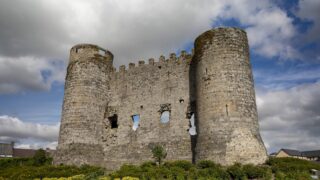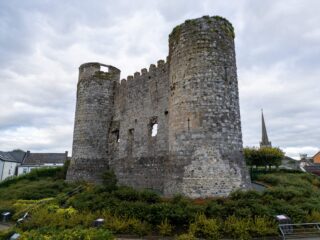Fógra
WARNING: It should be noted that these sites are unguided and a level of care and caution should be maintained during all stages of your visit. The Office Of Public Works (OPW) will not be held responsible for any damages, injuries, or losses that occur
Carlow Castle
Carlow Castle, situated at the meeting of the Rivers Barrow and Burren in Carlow town, was constructed in the early 13th century. Functioning as an administrative centre, military fortification, and residence, the castle represents a significant example of Norman architecture in Ireland.
The 13th century structure replaced an earlier Norman earthwork fortification and is dated to between 1208 and 1213. Its construction is attributed to William Marshal, often referred to as “the greatest knight that ever lived.” Marshal inherited the Lordship of Leinster through his wife, Isabel de Clare, daughter of Aoife MacMurrough and Richard Fitz Gilbert de Clare.
Carlow Castle is not unique in its design and layout, it belongs to a small group of early stone castles known as four-towered keeps. This group includes Ferns Castle in County Wexford, Lea Castle in County Laois, and the original Kilkenny Castle in County Kilkenny, all credited to William Marshal, Lord of Leinster. These castles exhibit a rectangular design with cylindrical drum towers at each corner and cross-shaped arrow loop windows. Such architectural features were also prevalent in western France during the same period, suggesting Marshal’s influence on their design as he spent much of his early life in France.
Excavations conducted in the 1990s revealed that the original structure was two storeys high, with some outer walls extending above the roof level. The castle walls measured 2.7 meters in thickness and rose from a battered plinth. The floors and roof were constructed from timber, with stone staircases embedded within the walls, providing access to the upper levels and roof. The entrance to the castle was located at first-floor level, accessible via a doorway in the north wall. A third storey was added to the castle in the late 14th century to accommodate the Irish Exchequer, along with its administrative officials and clerks. Additionally, the defences surrounding the castle were upgraded during this period.
Ownership of the castle changed hands multiple times. Upon his death in 1306, William Marshal’s grand-nephew bequeathed the castle to the Crown, and it was subsequently granted to Thomas Plantagenet, who became the Earl of Norfolk. It remained in his family until it was confiscated by the Crown in 1537 due to absentee landlordism. Throughout the 1640s, the castle changed ownership repeatedly before being seized by Cromwell in 1650.
The castle suffered significant damage in 1814 when it was granted to Dr Philip Parry Middleton, a local physician. In an attempt to create additional space for a lunatic asylum, Dr Middleton employed explosive charges at the castle's base. A report published in the Carlow Sentinel in 1904 by Lord Walter Fitzgerald noted that “Dr Middleton adopted what he thought was the speedier process of converting the vaulted interior into additional space by means of blasting powder. The result of his ignorance and folly was the collapse of the eastern half of the castle, leaving it in the condition we now see.” Consequently, much of the castle had to be demolished for safety reasons, resulting in the preservation of only two towers and an intervening wall visible today.
Visit Historic Environment Viewer for more information on Carlow Castle
Protect our Past - Click here to read about the importance of protecting our country’s unique heritage sites
This national monument is protected in accordance with the National Monuments Acts 1930 to 2014
Gailearaí
Suíomhanna cóngarach
Gairdíní Altamont
Gairdíní den tseandéanamh a bhfuil atmaisféar dá gcuid féin acu
Timpeall 18.1 km ón
Dearc Fhearna
Áit spéisiúil uathúil ina dtagann an stair agus an gheolaíocht le chéile
Timpeall 23.8 km ón
Teampall Mhuire, Gabhrán
Eaglais in bhfuil clocha oghaim, samhlacha de ridirí agus cuimhneacháin nuachlasaiceacha
Timpeall 24.6 km ón



